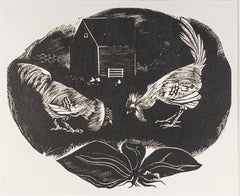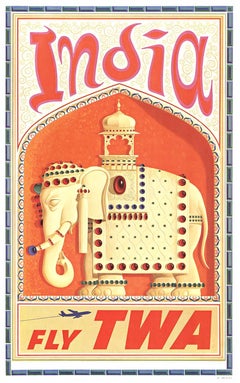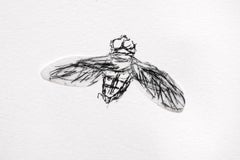Howard Thomas Animal Prints
to
2
Overall Width
to
Overall Height
to
2
3
195
161
116
94
2
2
1
1
2
2
1
1
2
2
Artist: Howard Thomas
"Brahma vs. Leghorn, " Farm Scene Wood Engraving by Howard Thomas
By Howard Thomas
Located in Milwaukee, WI
"Brahma vs. Leghorn" is an original wood engraving by Howard Thomas. In front of an understated farm house, Brahma and Leghorn face off, ready to battle. An unidentified plant sits on the center. Unsigned.
Image: 6" x 7.44"
Framed: 13.75" x 15.18
Thomas Howard (1899-1971) born a Quaker in Ohio, trained in the Midwest at Ohio State University and the Chicago Art Institute. He taught in the Art Department of the Milwaukee State Teachers College (now University of Wisconsin-Milwaukee) where he became good friends with Carl Holty, Edward Boerner, Robert von Neumann...
Category
1930s American Modern Howard Thomas Animal Prints
Materials
Woodcut
"White Horse, " Wood Engraving signed in Image by Howard Thomas
By Howard Thomas
Located in Milwaukee, WI
"White Horse" is an original wood engraving by Howard Thomas, signed in plate. A white horse trots past the foreground of the image, spirals in it's eyes and spots on its hide. A bla...
Category
1930s American Modern Howard Thomas Animal Prints
Materials
Woodcut
Related Items
Original Fly TWA India vintage travel poster David Klein
By David Klein
Located in Spokane, WA
Original Fly TWA India vintage travel poster. Artist: David Klein. Archival linen backed in very fine condition, ready to frame.
This poster features a...
Category
1960s American Modern Howard Thomas Animal Prints
Materials
Offset
$999
H 40 in W 25 in D 0.05 in
Kiki Smith Lithograph/Collage Various Flying Creatures "bee" Signed Dated
By Kiki Smith
Located in Detroit, MI
A collage lithograph from her series Various Flying Creatures by Kiki Smith titled: "bee." Smith has used one of her animal/insect iconic figures for this glassine paper and wove pap...
Category
1990s American Modern Howard Thomas Animal Prints
Materials
Paper, Lithograph
$1,500
H 19.75 in W 16.5 in
Haystack
By Thomas Hart Benton
Located in London, GB
A fine impression of this very popular image with full margins (smaller on top and bottom) published by Associated American Artists.
Category
1930s American Modern Howard Thomas Animal Prints
Materials
Lithograph
Original "Keep Him Free, Buy War Savings Stamps" excellent vintage WW1 poster
Located in Spokane, WA
Original WW1 US propaganda poster designed by Charles Livingston Bull (1874-1932) and entitled “Keep Him Free Buy War Savings Stamps”. This poster was issued to promote the US Treasu...
Category
1910s American Modern Howard Thomas Animal Prints
Materials
Lithograph
$1,198
H 30 in W 20.25 in D 0.05 in
Nebraska Evening
By Thomas Hart Benton
Located in London, GB
A fine impression with good margins published by Associated American Artists.
Category
1940s American Modern Howard Thomas Animal Prints
Materials
Lithograph
Stag
By Leonard Baskin
Located in San Francisco, CA
This artwork titled "Stag" 1957 is an original woodcut on laid paper by noted American artist Leonard Baskin, 1922-2000. It is hand signed and inscribed A.P. (Artist Proof) pencil by...
Category
Mid-20th Century American Modern Howard Thomas Animal Prints
Materials
Woodcut
Original "The Ships Are Coming" vintage American poster with an Eagle.
By James Henry Daugherty
Located in Spokane, WA
Original: THE SHIPS ARE COMING vintage poster. Artist: James H. Daugherty (1889-1974)
Publisher: U.S. Shipping Board, Emergency Fleet Corporation, Publication Section, Philadelphia, 1917.
Poster showing a giant eagle...
Category
1910s American Modern Howard Thomas Animal Prints
Materials
Lithograph
James Henry DaughertyOriginal "The Ships Are Coming" vintage American poster with an Eagle., 1917-18
$1,663 Sale Price
20% Off
H 30 in W 20 in D 0.05 in
Original Coppertone suntan lotion vintage poster - Italian
Located in Spokane, WA
Original “Coppertone” Colore di Rame vintage Italian poster. Colore de Rame translates into the color of copper.
Abbronzatevi! (suntan)
Non bruciatevi! (don’t burn)
Archival linen-backed in fine condition, ready to frame.
This original Coppertone poster is in A condition.
The background in the poster is a brighter yellow; after all, it is a sunny day, and you need suntan lotion!
Coppertone is an American suntan cream. Interestingly, the American poster of this famous little girl and dog...
Category
1960s American Modern Howard Thomas Animal Prints
Materials
Offset
$1,598
H 55 in W 39 in D 0.05 in
Original Hawaii, United Air Lines vintage travel poster Hawaiiana
Located in Spokane, WA
Original United Air Lines Hawaii vintage travel poster. Archival linen backed in excellent condition, ready to frame. The images shown are of the ...
Category
1960s American Modern Howard Thomas Animal Prints
Materials
Offset
$599
H 40 in W 25 in D 0.05 in
Original Chicago Fly TWA vintage travel poster
By David Klein
Located in Spokane, WA
Original vintage travel poster: Chicago - Fly TWA. UP UP and Away Trans World Airline. Artist: David Klein. Size 25" x 40" Dated 1960's. ...
Category
1960s American Modern Howard Thomas Animal Prints
Materials
Offset
2 Lazy 2 P
Located in Phoenix, AZ
2 Lazy 2P, ca. 1939
Lon Megargee
Serigraph
20 x 24 inches
Signed in screen
Original serigraph print by Lon Megargee 1883 - 1960
Featured in "Hot Irons" by Oren Arnold and John Hale, 1940
SHIPPING CHARGES INCLUDE SHIPPING, PACKAGING & INSURANCE
Lon Megargee created this serigraph from his commission with Oren Arnold and John Hale to do their dust jacket for the book, " Hot Irons", 1940. Arnold and Hale wanted to establish a reference work, an "authority", with a entertaining history about the evolution of the brand. Megargee created a painting of a steer that was branded with the script, 2 Lazy 2 P. Surrounding the steer is a random display of famous brands of ranches in the Southwest. It was well received and must have prompted Megargee to create the likeness as a print.
The brand is described in chapter thirteen, page 207-208 and says, " Ed Stram, who was Arizona state veterinarian for sixteen years, fire-branded his cattle with this peculiar crest. It isn't peculiar unless you have an equally peculiar sense of humor. At a glance it appears to be just another typically unimaginative brand, but it has been used to make many a thousand girls blush, and a few thousand bashful young men as well".
COLLIER GALLERY, FINE ART ESTATE OF LON MEGARGEE
Born and raised in Philadelphia, Pennsylvania, Lon Megargee, at age 13, ran away from his upper class home and went West in 1896 led by his zest for the wild and adventuresome life. There he established a reputation as a cowboy painter and illustrator with work most associated with Arizona Brewing Company ads featuring humorous aspects of cowboy life.
In his youth, he worked as a free-lance cowboy, exhibition roper, poker dealer, and bronco buster in Arizona, and then went east again to study art in Philadelphia at the Pennsylvania Academy of Fine Arts, and to New York at the Art Students League and Pratt Institute.
He returned to Arizona, living in Cave Creek, Salt River Canyon, Phoenix and the last years of his life near Sedona. His Phoenix home later became a popular hotel and dining place called the Hermosa Inn.
Megargee was a ranch owner and also did oil canvases of the places he loved and the cowboy life he admired. By 1910, he was among the earliest resident artists, and was probably the best known artist in Arizona. His name was first associated with a landscape series of 15 large murals for the Capitol Building, newly constructed just after Arizona became a state in 1912. Another one of his paintings, Elemental, was the first painting by an artist living in Arizona to be acquired for the Municipal Collection of Phoenix. These works were chosen from entries in the State Fair, where he continued to win prizes for figure and landscape painting.
From 1911 to 1953, he did numerous commission works for the Santa Fe Railroad, including a work titledNavajos Watching a Santa Fe Train. Between 1915 and 1930, he also painted in the Los Angeles area of California and had entries in the California State Fair. He died in Cottonwood, Arizona. After his death, theSaturday Evening Post had a double-page reproduction of his painting Cowboy's Dream.
Creator of the iconic logo for the Stetson Hat Company, " Last Drop From his Stetson", still in use today.
Fine Art Estate of Lon Megargee
We offer signed in print and original signature block prints. Custom, hand carved, signature frames, with archival standards and a speciality in hand dyed mats and french matting are provided for a beautiful and timeless presentation.
Megargee explored different mediums; printmaking captivated him in particular. The contrast of the black and white block print method captured perfectly his interpretation of a bold American West. The first print was produced around 1921 and culminated with the creation of “The Cowboy Builds a Loop” in 1933 with 28 images and poetry by his friend, Roy George. Megargee continued producing prints throughout the 1940s and early 50s.
At age 13, Lon Megargee came to Phoenix in 1896 following the death of his father in Philadelphia. For several years he resided with relatives while working at an uncle’s dairy farm and at odd jobs. He returned to Philadelphia in 1898 – 1899 in order to attend drawing classes at the Pennsylvania Academy of the Fine Arts. Back in Phoenix in 1899, he decided at the age of 16 to try to make his living as a cowboy. Lon moved to the cow country of Wickenburg where he was hired by Tex Singleton’s Bull Ranch. He later joined the Three Bar Ranch . . . and, after a few years, was offered a job by Billy Cook...
Category
1930s American Modern Howard Thomas Animal Prints
Materials
Screen
Original Philips Infra-Rouge vintage poster linen-backed
Located in Spokane, WA
Original Philips Infra-Rouge vintage poster. Size: 23" x 31". Archival linen-backed French antique poster. It is archival linen backed and ready to frame.
This fun kitchen poster...
Category
1940s American Modern Howard Thomas Animal Prints
Materials
Lithograph
$311 Sale Price
20% Off
H 31 in W 23 in D 0.05 in
Howard Thomas animal prints for sale on 1stDibs.
Find a wide variety of authentic Howard Thomas animal prints available for sale on 1stDibs. You can also browse by medium to find art by Howard Thomas in woodcut print and more. Much of the original work by this artist or collective was created during the 1930s and is mostly associated with the modern style. Not every interior allows for large Howard Thomas animal prints, so small editions measuring 14 inches across are available. Customers who are interested in this artist might also find the work of Ray H. French, Carol Wax, and Beniamino Bufano. Howard Thomas animal prints prices can differ depending upon medium, time period and other attributes. On 1stDibs, the price for these items starts at $1,283 and tops out at $1,285, while the average work can sell for $1,284.



